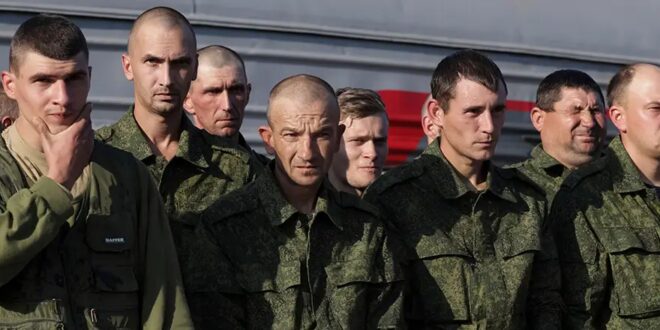The Russian government has launched a video campaign drawing on a number of themes in an attempt to persuade its citizens to enlist. But has it achieved the desired effect?
In September 2022, the Russian government announced the beginning of so-called ‘partial military conscription’, which reflected the failure of President Vladimir Putin’s initial plan for a quick and easy takeover of Ukraine. This announcement came as a shock for Russians, who suddenly realised that the war was much closer to home than it had previously felt. This resulted in mass protests, enlistment offices being set on fire, and even lone-wolf attacks on military officers. It turned out that not only did people who were against the war from the beginning not want to fight, but also the supporters of the so-called ‘special military operation’ were not ready to die in it.
The Russian government came to an understanding that hard power alone would not be enough to meet the threshold of 300,000 recruits that it had initially set, and that it might also eventually have unpredictable consequences. These considerations likely led the government to start a campaign to convince men of military age to fight.
Shortly after the mobilisation started, Russian social media platforms as well as video services such as Yandex and YouTube were populated with so-called social adverts, explaining to Russians the benefits of taking part in the Ukraine war. In these videos, one can see various stories of ‘typical’ Russians who make the decision to enlist. The Russian government did not rely only on its own strategic communicators. As one of the main sources of manpower for the war, the government-affiliated private military company, the Wagner group, seems to be actively engaging in recruitment as well.
The war is presented as a perfect opportunity to solve any financial problems that Russians may haveBoth the government-produced videos and Wagner’s social media use several narratives to convince individuals to sign up.
Money
Despite the never-ending talk on Russian television and news channels connecting support for the ‘special military operation’ with being a patriot, the main message of the recruitment materials is somewhat different. Many government videos show scenes of poor Russians struggling with money, and the war is presented as a way to solve this problem. The videos depict different stories, all with the same premise: a father who is sick of his low-paid job and who wants to buy an iPhone for his daughter; a young man whose grandad is about to sell his beloved old car to make sure they have something to eat; a man who is in debt and being chased by collectors. The same idea is being promoted on Wagner’s social media, which openly states the salary its fighters will receive – a figure several times higher than the wage of an average Russian. The war, therefore, is presented as a perfect opportunity to solve any financial problems that Russians may have.
Finding Meaning in Life
Many videos present Russians as always drinking, having nothing to do or live for, or having no interest in life. This narrative seems to target young people and war veterans in particular, who are depicted as struggling to find their place in civilian life. The war is presented as the best way to live a full life and to do something important and significant.
As mentioned, the government-produced videos do not include any mention of patriotism, which is strange given that the war is presented in the context of ‘saving the nation’. However, Wagner’s messaging does exploit this trope. While one would expect the private military company to be solely focused on profit, the idea that Wagner fighters are patriots and defending their country appears to be very prominent. The group often posts videos and text-based content which connect joining the company with being a real patriot and a defender of the country. The Wagner fighter is presented as a model citizen, who is not afraid of death when it comes to serving his country.
Masculinity
The war is the best thing that a man can do; the war makes a boy a man; a real man is a warrior and only a warrior has a strong moral standing – these ideas are being disseminated in many government-produced videos, as well as those circulated by Wagner. Moreover, the narrative of masculinity is also connected with attractiveness to women. In several videos, one can observe a storyline where a girl the main character likes would not pay attention to him, but after he fights in the war, she falls in love with him. A large portion of the comments under the Wagner Group’s posts are also made by women (or accounts with female names). All these comments express support and admiration for the fighters, praising their bravery and might. This further strengthens the overall narrative that once one becomes a warrior, a whole series of opportunities will open up, including relationships.
Excitement and Adventure
To resonate with younger audiences, the government deploys a narrative of adventure. One of the videos depicts a gamer who is playing a war game, with the motto ‘we fight real wars’. The message is clear – instead of fighting in a video game, one can experience the excitement of battle in real life. Wagner also uses this approach by posting videos from the battlefield shot with GoPro cameras attached to its fighters.
The government-produced videos do not include any mention of patriotism, which is strange given that the war is presented in the context of ‘saving the nation’If the content posted by Wagner is of a fairly high quality – slick design, good music, high-quality footage – the same cannot be said of the government-produced videos. Not only is the quality of the footage rather poor, but the overall setup has been characterised by many viewers as ‘cringy’. The acting is extremely unbelievable and so are the scenes – people who are meant to be poor and unsuccessful are depicted living in good houses with chimneys. The overall campaign caused outrage among the Russian public – not just among those who are anti-war, but also among the invasion’s supporters. People were angry that the government presented Russians as worthless, stagnating alcoholics with no future, for whom the only hope to finally become someone is to join the war. Needless to say, the campaign did not work, and Russians have continued to look for ways to escape the country or avoid any contact with military officers.
The Russian government continues its attempts to sell the appeal of fighting to its citizens. However, it has become clear that even the most convinced patriots do not buy the messages from the cringy social adverts. The government now seems to rely more on less direct methods of persuasion such as those used by Wagner, or pro-Kremlin bloggers such as Stas Ai Kak Prosto (or Stas Oh So Simple), who have a wider reach and stronger trust from their audience and who can thus deliver the government’s message to their followers. However, according to an unofficial government poll, 55% of Russians would like to see negotiations with Ukraine, which means that it is becoming more and more difficult to convince the population of the necessity of this war.
 Eurasia Press & News
Eurasia Press & News



